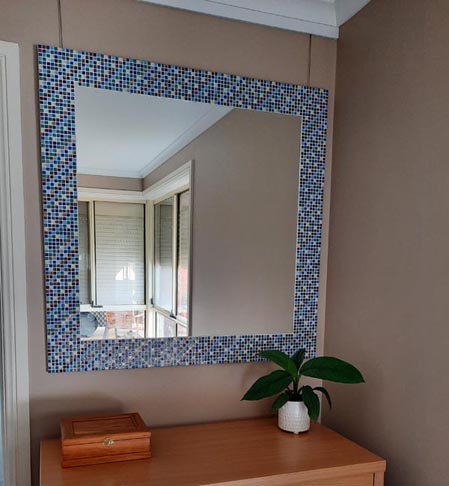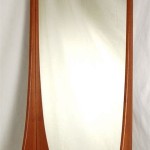Can You Put a Mirror On a Stud Wall? A Comprehensive Guide
Hanging a mirror on a wall is a common home décor project, enhancing aesthetics and creating an illusion of space. However, the process becomes more specific when the wall in question is a stud wall. Stud walls, commonly found in modern homes, are constructed with vertical wooden or metal studs covered with drywall. Understanding the construction and limitations of a stud wall is crucial for safely and securely mounting a mirror.
The primary concern when hanging anything substantial on a stud wall is weight distribution and anchor security. Drywall alone offers minimal support, meaning the mirror's weight must be adequately transferred to the studs. Failing to do so can result in the mirror falling, causing damage to the wall, the mirror, and potentially even injury. This article provides a detailed guide on how to safely and effectively install a mirror on a stud wall, covering essential considerations, necessary tools, and step-by-step instructions.
Identifying Studs and Their Importance
The first and most crucial step is locating the studs within the wall. Studs are typically spaced 16 or 24 inches apart on center, meaning the distance from the center of one stud to the center of the next is either 16 or 24 inches. The spacing can vary slightly depending on building codes and construction practices. Identifying the stud locations is paramount because they provide the solid support necessary to hold the mirror's weight.
Several methods can be used to locate studs:
- Stud Finder: An electronic stud finder is the most reliable and efficient tool. There are two primary types: magnetic stud finders, which detect metal fasteners used to secure the drywall to the studs, and electronic stud finders, which detect changes in density behind the wall.
- Tapping: This method involves tapping the wall lightly. A solid sound usually indicates a stud, while a hollow sound suggests empty space between the studs. This method is less accurate but can provide a general idea of stud locations.
- Measuring: If you know the general stud spacing (16 or 24 inches), you can start from a corner or doorway, where a stud is typically located, and measure across the wall to find subsequent studs.
- Visual Clues: Sometimes, subtle visual cues, such as nail pops or slight indentations in the drywall, can indicate the presence of a stud beneath.
Once you suspect the location of a stud, confirm it by driving a small nail or screw into the wall. If it hits solid wood, you've found a stud. If it goes through easily without resistance, you’re in the empty space between studs. Mark the stud locations clearly with a pencil, extending the line vertically to provide a clear target area for your mounting hardware.
Understanding the stud placement is vital for selecting the appropriate mounting hardware and distributing the mirror's weight effectively. It directly impacts the stability and longevity of the installation, preventing potential accidents and wall damage. When using a stud finder, always calibrate it correctly and test it in a known stud location to ensure accuracy before proceeding with any drilling or hammering.
Choosing the Right Mounting Hardware
Selecting the appropriate mounting hardware is critical for a successful and safe mirror installation. The choice depends on several factors, including the weight of the mirror, the type of hanging mechanism on the mirror, and the nature of the stud wall itself (wood or metal studs). Using insufficient or incorrect hardware can lead to the mirror detaching from the wall.
Here are several types of mounting hardware commonly used for mirrors on stud walls:
- Screws: Screws are a reliable option for securing mirrors to wood studs. Choose screws that are long enough to penetrate at least 1 inch into the stud. Drywall screws are generally not suitable, as they are brittle and prone to snapping. Instead, opt for wood screws with a coarse thread for better grip.
- Wall Anchors: While the primary support should come from the studs, wall anchors can provide additional support, especially if the mirror's hanging points do not align perfectly with the studs. Various types of wall anchors exist, including toggle bolts, molly bolts, and self-drilling anchors. However, their load-bearing capacity is significantly less than that of screws directly into studs. Wall anchors are best used for lighter mirrors or to supplement stud support.
- Heavy-Duty Hooks: If the mirror has D-rings or wire for hanging, heavy-duty hooks can be used to attach it to the wall. Ensure the hooks are rated for the mirror's weight and are securely screwed into the studs.
- Mirror Mounting Clips: These clips are specifically designed for holding mirrors and come in various sizes and styles. They are typically installed at the top and bottom of the mirror, providing a secure and aesthetically pleasing mounting solution. When using mirror mounting clips, ensure they are also screwed into the studs whenever possible.
When selecting screws, consider the size and type of the mirror's hanging hardware. The screw head should be large enough to securely hold the hardware but not so large that it interferes with its function. Pre-drilling pilot holes before inserting screws is also recommended, especially for hardwood studs, to prevent the wood from splitting. Always check the weight rating of any mounting hardware to ensure it can safely support the mirror's weight. Consult with a hardware professional if you are unsure about the best hardware for your specific mirror and wall type.
Step-by-Step Installation Guide
Following a systematic approach ensures a secure and aesthetically pleasing mirror installation. This step-by-step guide provides a general framework, but specific details may vary depending on the mirror's design and the chosen mounting hardware.
Step 1: Gather Your Tools and Materials
Before starting, assemble all necessary tools and materials:
- Stud Finder
- Pencil
- Level
- Measuring Tape
- Drill
- Screwdriver
- Screws or other chosen mounting hardware
- Safety Glasses
- Gloves (optional)
Step 2: Locate and Mark Studs
Use a stud finder to locate the studs behind the wall. Mark the locations clearly with a pencil, extending the lines vertically to ensure a clear target for your hardware. Double-check the stud locations by driving a small nail or screw into the wall.
Step 3: Measure and Plan the Mirror's Placement
Determine the desired height and position of the mirror on the wall. Use a measuring tape and level to ensure the mirror will be straight and centered. Mark the top edge of the mirror with a pencil.
Step 4: Pre-Drill Pilot Holes (If Necessary)
If using screws, pre-drill pilot holes through the drywall and into the studs at the marked locations. This is especially important for hardwood studs to prevent splitting. The pilot hole should be slightly smaller than the screw's diameter.
Step 5: Install the Mounting Hardware
Attach the chosen mounting hardware to the wall, aligning it with the marked stud locations. Use a screwdriver or drill to securely fasten the screws into the studs. If using mirror mounting clips, install the bottom clips first, ensuring they are level. Then, install the top clips, leaving enough space to slide the mirror in.
Step 6: Hang the Mirror
Carefully lift the mirror and hang it on the installed hardware. If using D-rings or wire, position the mirror so the rings or wire are securely resting on the hooks. If using mirror mounting clips, slide the mirror into the clips from the bottom and secure it in place.
Step 7: Check for Stability and Level
Once the mirror is hung, double-check that it is level and securely attached to the wall. Gently push on the mirror to ensure it is stable and does not wobble. Adjust the mounting hardware if necessary to achieve a secure and level installation.
Step 8: Final Adjustments and Cleanup
Make any final adjustments to the mirror's position and clean up any debris from the installation process. Patch any unnecessary holes with spackle and touch up the paint if needed.
Adhering to these steps and prioritizing safety during the installation process ensures a securely mounted mirror that enhances the room's aesthetics without compromising structural integrity. When in doubt, consult a professional installer for assistance.
How To Hang A 100 Pound Mirror On Drywall Quora

Hanging Heavy Mirror On Plaster Walls 6 Steps With Pictures Instructables

Mirrors Are Heavy The Hook And Nail Must Go Into A Stud But If Isn T In Right Spot What To Do Hanging Mirror

How To Hang A Mirror On Plasterboard Wall Soraya Interiors

How To Hang A Heavy Mirror Securely Bob Vila

How To Hang A Large Or Heavy Mirror

How To Hang A Very Heavy Picture Or Mirror The Best

How To Hang A Heavy Mirror C R F T

How To Hang A Frameless Mirror On The Wall With Pictures

How To Hang A Large Wall Mirror Step By Tutorial








